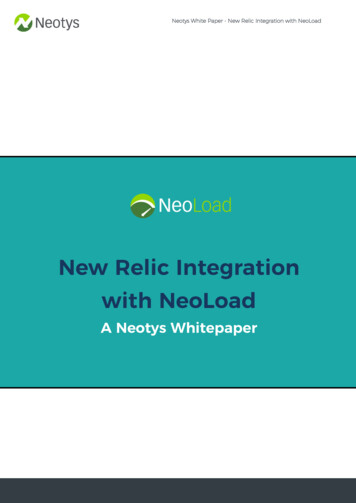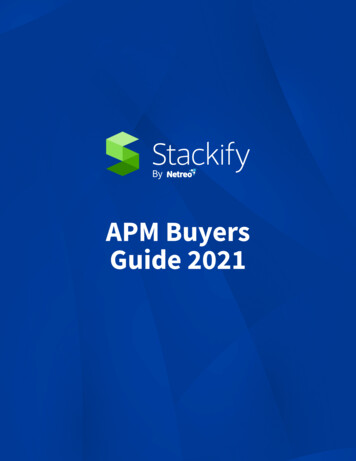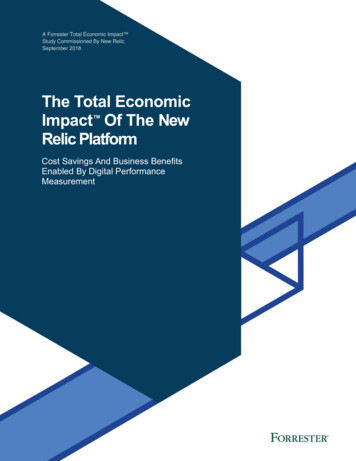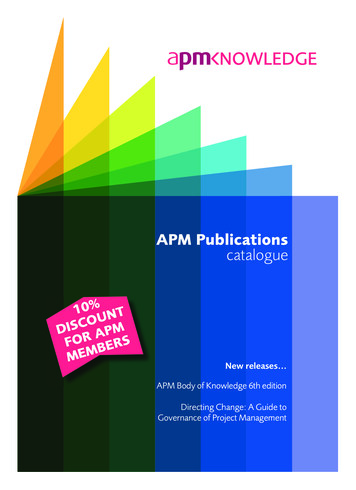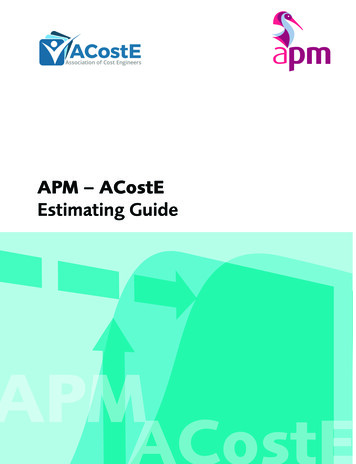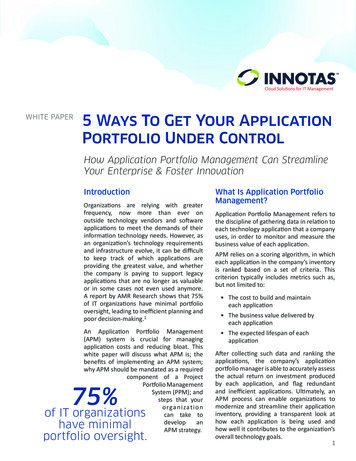
Transcription
ChecklistNew Relic APM Best Practices10 Application Monitoring Tips You Need To KnowIt’s one thing to know how to use New Relic APM, but it’s another thing to know how to use New Relic’s application performance monitoringsoftware well. Here are 10 best practices designed to help you become a New Relic APM master—and a key asset to your team!1Standardize application-naming conventionsmature APM customers use are application name and environment.Most New Relic agents provide a default application name, such asSo, for example, if you wanted to view the billing application inTest, you could simply filter by “billing app” (name label) and“My Application” or “PHP Application,” if you don’t specify one inyour New Relic configuration file. You don’t want to end up with 20“test” (environment label).identically named applications, so always be sure to select aNew Relic APM is designed so that account owners and adminsdescriptive identifier for your apps as soon you deploy them.can label apps to “roll up” into an unlimited number of meaningfulTo keep things consistent and easy to navigate, New Relic recom-categories. You can also easily sort, filter, and page through allmends standardizing your application naming (e.g. all apps in Stagingapplications on your account’s Applications list.append [Staging] or the like at the end of their names.) Ideally,HOW TO DO IT:you want your new Java applications to be named automatically1. From the New Relic APM menu bar, select Applications.to reduce the chances of typographical errors and misnaming.2. From the Applications index, select Show Labels On.HOW TO DO IT:3. To assign an app to a category, select the circled plus icon by1. For Java applications, automatic application naming can comeits name.from the following sources:4. Follow the guidelines to type the label; use the format Request attributeCategory:Value. Servlet init parameter5. To save the new label, press Enter or Return. Filter init parameter Web app context parameter Web app context name (display name) Web app context pathChoose the method that best fits your needs and followthese steps.2. For non-Java applications, there are no automatic namingmethods so refer to the documentation for your agent.2Add labels to your applicationsWhen several different applications use the same account, andeach application spans multiple environments (for example,development, test, pre-production, production), it can be hard tofind a specific application in your overview dashboard. That’s whywe recommend adding labels to your apps so that you can segment them into logical groups. The two most common labels that3Create and evaluate alert policiesWhen key performance indicators spike or drop, individuals andteams in your organization need to be notified. Alerting in NewRelic provides a set of tools including dynamic baselines that allowyou to detect problems before they impact your end users.
New Relic APM Best Practices: 10 Application Monitoring Tips You Need To KnowAlert policies can be set up in two primary ways:3. Using the threshold sliders, you can then set how closely youwant your threshold to follow the baseline prediction. Static threshold alerts are great when you already know thenature of an application and its normal behaviors aren’tTo set up static threshold alerts:likely to change anytime soon. Apdex score, response time,1. To change your Apdex settings, go here.error rate, throughput are some of the static thresholds2. To set up your alert notification channels, go here.you can create alert policies on. Dynamic baseline alerts make it easy to determine and setdynamic alert thresholds for applications with varying4 Identify and set up key transactionsDepending on the nature of your application, some transactionsseasonal patterns and growth trends (which make it difficultmay be more important to you than others. New Relic’s keyto set thresholds that define normal behavior). These alertstransactions feature is designed to help you closely monitor whatuse baselines modeled from your application’s historicalyou consider to be your app’s most business-critical transactions—metric data.whether that’s end-user or app response time, call counts, errorEach alert policy can contain as many conditions as you need, andrates, or something else. You can also set alert threshold levelseach alert condition includes three components:for notifications when your key transactions are performing poorly. Type of condition (metric, external service, and so on)HOW TO DO IT: Entities that the policy targets (for example, apps monitored1. From the New Relic APM or New Relic Browser menu bar,by New Relic APM or New Relic Browser, hosts monitoredselect Key transactions, and select Add more. Then selectby New Relic Infrastructure, and so on)the app and web transaction. OR from the selected transaction, select Track as key transaction. Thresholds that escalate into alerting situations withincreasing severity2. Type a name for the key transaction, and select Track keytransaction.Once you have your alerting set up, you then want to make sure3. Optional: If the agent for the selected app supports customyou’re taking advantage of all viable notification channels. Afteralerting, use the default values that New Relic automaticallyall, what good are alerts if no one knows about them? You canfills, or select Edit key alert transaction policy to set the Apdexmanage alerts by creating specific user groups and by leveragingand alert threshold values.New Relic’s integrated alert channels, including HipChat, JIRA,4. To view the key transactions dashboard details, select ViewPagerDuty, Campfire, Webhook, and email. Be sure to evaluate alertnew key transaction.policies on a regular basis to ensure that they are always valid.HOW TO DO IT:To set up dynamic baseline alerts:1. To select the Dynamic Baseline Alerts capability and choose5Track deployment historyWhen development teams are pushing new code out as frequentlyan application, go here. You will see a preview of the metricas possible, it can be hard to measure the impact that eachwith the predicted baseline.deployment is having on performance. One way to stay in tune2. From the drop-down menu, you can select a metric for thatapplication and see the corresponding baseline.with how these changes are affecting your application is viadeployment reports. These reports list recent deployments and
New Relic APM Best Practices: 10 Application Monitoring Tips You Need To KnowHOW TO DO IT:their impact on end-users and app servers’ Apdex scores, alongwith response times, throughput, and errors. You can also view1. Start with the Error rate chart to see at a glance where thereand drill down into the details to catch errors related to recentare unexpected spikes, dips or patterns in general.deployments, or file a ticket and share details with your team.2. Correlate general patterns on the Top 5 errors chart to alertsoccurring during the same time period. Use groups and filtersHOW TO DO IT:to examine the error events and attributes in more detail, and1. To view the Deployments dashboard, from the New Relic menubar, select APM (selected app) Events Deployments.look for patterns with error messages or transaction names.2. To view performance after a deployment, go to the selected3. Explore and share Error trace table information, includingspecific stack trace details: associated host, user, frameworkapp’s Overview dashboard in the Recent events section.code, customer attributes, etc.Keep in mind that a blue vertical bar on a chart indicates a4. Identify error patterns on the Error frequency heatmap for adeployment. To view summary information about the deploy-selected grouping (host, error message, custom attributes,ment, point to the blue bar.6etc) within a time range.Start troubleshooting errors using error analyticsThe New Relic APM error analytics feature gives you useful tools7Leverage New Relic’s reporting capabilitiesto analyze and resolve errors being reported by your applications,From SLA, deployment, and capacity to scalability, host usageso you can immediately see where to focus your attention. DevOpsreports, and more, New Relic APM offers a variety of downloadableteams can:reporting tools surfacing historical trends—all great ways to reportto senior executive teams or customers. Take a look at the full list Assess the health of applications with fine-grained data onof reports and use them to your advantage.error events over the past eight days.HOW TO DO IT: Select any parameter to group or filter errors shown; forexample, error class, error message, host, transaction1. To view a report, from the New Relic APM menu bar, selectname, etc.Applications (selected app) Reports. Drill down into stack trace details to diagnose and resolve2. Select the report you’d like to see.specific errors.3. If you want to save or export a report to share, select Down- Identify continuing trends in error rates for periods longerload this report as .csv, which will create a report withthan eight days. Use links to share error data through New Relic Insightsdashboards or through your organization’s ticketingsystem to coordinate and resolve errors more quickly.comma-separated values.8Look at your environment holisticallyWith service mapsUse New Relic service maps, a feature included in APM, to understandhow apps and services in your architecture connect and talk toeach other. Service maps are visual, customizable representationsof your application architecture. Maps automatically show you yourapp’s connections and dependencies, including databases and externalservices. Health indicators and performance metrics show you thecurrent operational status for every part of your architecture.HOW TO DO IT:1. To access service maps, go to rpm.newrelic.com/apm Service maps.2. Name your map.3. Rearrange, group, or add nodes on the map as needed.
New Relic APM Best Practices: 10 Application Monitoring Tips You Need To KnowWith New Relic Insights9Keep your agents currentOffering a unified, end-to-end view, New Relic Insights lets you chartWith New Relic’s SaaS platform, getting new features is as easyand query all your APM data, both the metric and event data theas updating your agent. Most likely your organization alreadyagent reports, alongside data any other New Relic agents report.has a set of scripts for deploying application upgrades into yourIt’s all available in Insights out-of-the-box, from the time any ofenvironment. In a similar fashion, you can also automate yourthe agents, including APM, start reporting data to New Relic. YouNew Relic agent deployment to ensure that your systems are upcan extend your reported event data, with custom attributes andto date. Both Puppet and Chef scripts are great examples ofcustom events for even more dimension to segment your data.deployment frameworks that make life easier by allowing you toYou can also send third-party data to Insights.automate your entire deployment and management process.Use the data explorer to quickly browse your data taxonomy andHOW TO DO IT:add-to-insights to start adding charts from New Relic APM to acustom dashboard with a few clicks.During an incident, open Insights and quickly ask a series of questions about your system with the New Relic Query Language(NRQL). For example, you can: Show web and mobile application information, serverinformation, custom metric data, and plugin metric dataall on a single dashboard interface. Create dashboards that present charts and tables with auniform size and arrangement on a grid. Select existing New Relic charts for your dashboard, orcreate your own charts and tables.HOW TO DO IT:1. From the New Relic menu bar, select Dashboards CreateInsights dashboard.2. Type the dashboard’s title, or keep the default name.3. Optional: To create a dashboard with the selected applicationdata only, select the Legacy mode checkbox.1. Regularly review which version of the agent you’re using so thatyou know when an update is needed. If the latest agent releasecontains a needed fix or added functionality, download it.2. To deploy the agent manually: Back up the current agent directory. Deploy the updated agent into the existing agent directory. Modify configuration files by comparing new files withexisting files. In particular, make sure things like licensekey and custom extensions are copied over to the newconfiguration. Restart the application. If problems arise, restore the old agent using the backupand restart.3. To deploy the agent automatically (preferred as a method toavoid errors), you can either: Use existing deployment scripts, provided by they can beadapted to handle the deployment. Create and maintain a script that specifically deploys and4. Select the layout (Overview or Grid), and select Create.configures the New Relic agent. Ideally, the script would5. Reuse this user flow to add additional charts, tables, and datapull the agent files from a repository where the files areto your dashboard.versioned (for rollback purposes). Once the script hasbeen created:a. Shut down the application (unless script handles this).b. Run the deployment script.c. Start the application (unless script handles this).d. If problems arise, run the script to roll back to theprevious version.
New Relic APM Best Practices: 10 Application Monitoring Tips You Need To Know10 Enable role-based access (RBAC) and3. To upload your SAML Identity Provider certificate, selectsingle sign-on (SSO)Choose File, and then follow standard procedures to selectSecurity is no doubt of utmost concern to your organization. Toand save the file.simplify password management for your employees and strengthensecurity, you may already be using SSO with your other systems.You should do the same with New Relic. Using New Relic’s SSO4. Copy and paste in (or type) the Remove login URL that yourusers will use for Single Sign-On.5. If your organization’s SAML integration provides a redirectintegration feature, account administrators will be able to enforceURL for logout, copy and paste in (or type) the Logoutstrong passwords and restrict login via a corporate authenticationlanding URL; otherwise leave blank.mechanism. This way, New Relic users who have already authenticated using a corporate SSO system will be able to bypass the6. Save, test, and enable.New Relic login prompt.HOW TO DO IT:1. Log in to New Relic as an admin and go to the SSO configuration page. From the New Relic title bar, select (your accountname) Account Settings Integrations Single Sign On.2. From the SAML Single Sign On page, review your New RelicSAML Service Provider details.Want more user tips? View training videos at New Relic University. Read the documentation. Check out our Tutorials page. Ask a question in the New Relic Online Technical Community. Copyright 2017, New Relic, Inc. All rights reserved. All trademarks, trade names, service marks and logos referenced herein belong to their respective companies. 10.2017
Here are 10 best practices designed to help you become a New Relic APM master—and a key asset to your team! 2 3. New Relic APM Best Practices: 10 Application Monitoring Tips You Need To Know . JIRA, PagerDuty, Campfire, Webhook, and email. Be sure to evaluate alert policies on a regular basis to ensure that they are always valid. HOW TO DO .

